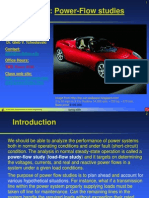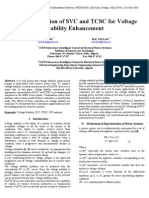Power Flow Analysis PDF
Power Flow Analysis PDF
Uploaded by
Awal SaktiCopyright:
Available Formats
Power Flow Analysis PDF
Power Flow Analysis PDF
Uploaded by
Awal SaktiOriginal Title
Copyright
Available Formats
Share this document
Did you find this document useful?
Is this content inappropriate?
Copyright:
Available Formats
Power Flow Analysis PDF
Power Flow Analysis PDF
Uploaded by
Awal SaktiCopyright:
Available Formats
Power Flow Analysis
Well known as : Load Flow
The Power Flow Problem
Power flow analysis is fundamental to the study of power
systems.
In fact, power flow forms the core of power system analysis.
power flow study plays a key role in the planning of additions
or expansions to transmission and generation facilities.
A power flow solution is often the starting point for many other
types of power system analyses.
In addition, power flow analysis is at the heart of contingency
analysis and the implementation of real-time monitoring
systems.
Problem Statement
For a given power network, with known complex
power loads and some set of specifications or
restrictions on power generations and voltages, solve
for any unknown bus voltages and unspecified
generation and finally for the complex power flow in the
network components.
Network Structure
Power Flow Study Steps
1. Determine element values for passive network
components.
2. Determine locations and values of all complex power
loads.
3. Determine generation specifications and constraints.
4. Develop a mathematical model describing power flow
in the network.
5. Solve for the voltage profile of the network.
6. Solve for the power flows and losses in the network.
7. Check for constraint violations.
Formulation of the Bus Admittance Matrix
The first step in developing the mathematical model describing
the power flow in the network is the formulation of the bus
admittance matrix.
The bus admittance matrix is an n*n matrix (where n is the
number of buses in the system) constructed from the
admittances of the equivalent circuit elements of the segments
making up the power system.
Most system segments are represented by a combination of
shunt elements (connected between a bus and the reference
node) and series elements (connected between two system
buses).
Bus Admittance Matrix
Formulation of the bus admittance matrix follows two
simple rules:
1. The admittance of elements connected between node k
and reference is added to the (k, k) entry of the
admittance matrix.
2. The admittance of elements connected between nodes
j and k is added to the (j, j) and (k, k) entries of the
admittance matrix.
The negative of the admittance is added to the (j, k) and
(k, j) entries of the admittance matrix.
Bus Admittance Matrix
Bus Admittance Matrix
Node-Voltage Equations
Applying KCL at each node yields: Defining the Ys as
The Y-Bus
The current equations reduced to
In a compact form
Where,
The General Form of the Load-Flow
Equations
In Practice, bus powers S
i
is specified rather than the bus
currents I
i
.
As a result, we have
) ( | | ) (
1 1
*
*
i n in n i in
N
n
N
n
n in
i
i i i i
V V Y V Y V I V jQ P + = = =
= =
ij ij ij ij ij ij ij ij ij
jB G Y j Y Y Y + = + = = sin | | cos | | | |
i
i
*
V
S
I =
Load-Flow Equations
These are the static power flow equations. Each equation is
complex, and therefore we have 2n real equations. The nodal
admittance matrix current equation can be written in the power
form:
) ( | | ) (
1 1
*
*
i n in n i in
N
n
N
n
n in
i
i i i i
V V Y V Y V I V jQ P + = = =
= =
Let,
ij ij ij ij ij ij ij ij ij
jB G Y j Y Y Y + = + = = sin | | cos | | | |
Load-Flow Equations
Finally,
=
+ + =
N
i n
n
i n in in n i ii i i
Y V V G V P
1
2
) cos( | | | |
o This is known as NR (Newton Raphson) formulation
=
+ =
N
i n
n
i n in in n i ii i i
Y V V B V Q
1
2
) sin( | | | |
Gauss Power Flow
*
* * *
i
1 1
* * * *
1 1
*
*
1 1,
*
*
1,
We first need to put the equation in the correct form
S
S
S
S 1
i i
i
i
n n
i i i ik k i ik k
k k
n n
i i i ik k ik k
k k
n n
i
ik k ii i ik k
k k k i
n
i
i ik k
ii k k i
V I V Y V V Y V
V I V Y V V Y V
Y V Y V Y V
V
V Y V
Y
V
= =
= =
= =
=
| |
= = =
|
\ .
= = =
= = +
|
=
|
|
|
\ .
Difficulties
Unless the generation equals the load at every bus, the
complex power outputs of the generators cannot be arbitrarily
selected.
In fact, the complex power output of at least one of the
generators must be calculated last, since it must take up the
unknown slack due to the uncalculated network losses.
Further, losses cannot be calculated until the voltages are
known.
Also, it is not possible to solve these equations for the
absolute phase angles of the phasor voltages. This simply
means that the problem can only be solved to some arbitrary
phase angle reference.
Difficulties
For a 4- bus system, suppose that S
G4
is arbitrarily allowed
to float or swing (in order to take up the necessary slack
caused by the losses) and that S
G1,
S
G2,
S
G3
are specified.
Remedies
Now, with the loads known, the equations are seen as
four simultaneous nonlinear equations with complex
coefficients in five unknowns. (V
1
, V
2
, V
3
, V
4
and S
G4
).
Designating bus 4 as the slack bus and specifying the
voltage V
4
reduces the problem to four equations in four
unknowns.
Remedies
The slack bus is chosen as the phase reference for all
phasor calculations, its magnitude is constrained, and the
complex power generation at this bus is free to take up
the slack necessary in order to account for the system
real and reactive power losses.
Systems of nonlinear equations, cannot (except in rare
cases) be solved by closed-form techniques.
Load Flow Solution
There are four quantities of interest associated with each bus:
1. Real Power, P
2. Reactive Power, Q
3. Voltage Magnitude, V
4. Voltage Angle,
At every bus of the system, two of these four quantities will be
specified and the remaining two will be unknowns.
Each of the system buses may be classified in accordance with
which of the two quantities are specified
Bus Classifications
Slack Bus The slack bus for the system is a single bus for which the
voltage magnitude and angle are specified.
The real and reactive power are unknowns.
The bus selected as the slack bus must have a source of both real
and reactive power, since the injected power at this bus must swing
to take up the slack in the solution.
The best choice for the slack bus (since, in most power systems,
many buses have real and reactive power sources) requires
experience with the particular system under study.
The behavior of the solution is often influenced by the bus chosen.
Bus Classifications
Load Bus (P-Q Bus) : A load bus is defined as any bus of the system
for which the real and reactive power are specified.
Load buses may contain generators with specified real and reactive
power outputs;
however, it is often convenient to designate any bus with specified
injected complex power as a load bus.
Voltage Controlled Bus (P-V Bus) : Any bus for which the voltage
magnitude and the injected real power are specified is classified as a
voltage controlled (or P-V) bus.
The injected reactive power is a variable (with specified upper and
lower bounds) in the power flow analysis.
(A P-V bus must have a variable source of reactive power such as a
generator.)
Solution Methods
The solution of the simultaneous nonlinear power flow
equations requires the use of iterative techniques for
even the simplest power systems.
There are many methods for solving nonlinear equations,
such as:
- Gauss Seidel.
- Newton Raphson.
- Fast Decoupled.
Guess Solution
It is important to have a good approximation to the load-
flow solution, which is then used as a starting estimate
(or initial guess) in the iterative procedure.
A fairly simple process can be used to evaluate a good
approximation to the unknown voltages and phase
angles.
The process is implemented in two stages: the first
calculates the approximate angles, and the second
calculates the approximate voltage magnitudes.
Gauss Iteration Method
Gauss Iteration Example
( 1) ( )
(0)
( ) ( )
Example: Solve - 1 0
1
Let k = 0 and arbitrarily guess x 1 and solve
0 1 5 2.61185
1 2 6 2.61612
2 2.41421 7 2.61744
3 2.55538 8 2.61785
4 2.59805 9 2.61798
v v
v v
x x
x x
k x k x
+
=
= +
=
Stopping Criteria
=
Gauss Power Flow
*
* * *
i
1 1
* * * *
1 1
*
*
1 1,
*
*
1,
We first need to put the equation in the correct form
S
S
S
S 1
i i
i
i
n n
i i i ik k i ik k
k k
n n
i i i ik k ik k
k k
n n
i
ik k ii i ik k
k k k i
n
i
i ik k
ii k k i
V I V Y V V Y V
V I V Y V V Y V
Y V Y V Y V
V
V Y V
Y
V
= =
= =
= =
=
| |
= = =
|
\ .
= = =
= = +
|
=
|
|
|
\ .
Example
A 100 MW, 50 Mvar load is connected to a generator through a line
with z = 0.02 + j0.06 p.u. and line charging of 0.05 p.u on each end
(100 MVA base). Also, there is a 0.25 p.u. capacitance at bus 2. If the
generator voltage is 1.0 p.u., what is V
2
?
100+j50
0.25 p.u.
Z = 0.02 + j0.06
V= 1 0
V
2
Y-Bus
2
2 bus
bus
22
The unknown is the complex load voltage, V .
To determine V we need to know the .
1
5 15
0.02 0.06
5 14.95 5 15
Hence
5 15 5 14.70
( Note - 15 0.05 0.25)
j
j
j j
j j
B j j j
=
+
+
(
=
(
+
= + +
Y
Y
Solution
*
2
2
*
22 1,
2
2
*
2
(0)
2
( ) ( )
2 2
1 S
1 -1 0.5
( 5 15)(1.0 0)
5 14.70
Guess 1.0 0 (this is known as a flat start)
0 1.000 0.000 3 0.9622 0.0556
1 0.9671 0.0568 4 0.9622 0.0556
2 0
n
ik k
k k i
v v
V Y V
Y
V
j
V j
j
V
V
v V v V
j j
j j
=
| |
=
|
\ .
| |
+
= +
|
\ .
=
+
.9624 0.0553 j
Solution (cont.)
Gauss-Seidel Iteration
( 1) ( ) ( ) ( )
2 1
2 2 3
( 1) ( 1) ( ) ( )
2 1 3 2 3
( 1) ( 1) ( 1) ( ) ( )
2 1 4 2 3 4
( 1) ( 1) ( 1) ( 1) ( )
2 1 2 3 4
Immediately use the new voltage estimates:
( , , , , )
( , , , , )
( , , , , )
( , , , ,
v v v v
n
v v v v
n
v v v v v
n
v v v v v
n n
V h V V V V
V h V V V V
V h V V V V V
V h V V V V V
+
+ +
+ + +
+ + + +
=
=
=
=
)
The Gauss-Seidel works better than the Gauss, and
is actually easier to implement. It is used instead
of Gauss.
You might also like
- ECE4762007 Lect12Document42 pagesECE4762007 Lect12Salvador JovenNo ratings yet
- CircuitanlyDocument32 pagesCircuitanlysetsindia3735No ratings yet
- Load Flow StudiesDocument54 pagesLoad Flow Studiesk rajendra100% (1)
- Experiment No 8Document4 pagesExperiment No 8smshamima265No ratings yet
- Power Flow AnalysisDocument68 pagesPower Flow AnalysisLuiz Pa100% (1)
- Chapter 6 From Power System Analysis - Hadi Saada With Answerst PDFDocument70 pagesChapter 6 From Power System Analysis - Hadi Saada With Answerst PDFطلال النسري33% (6)
- EE 368 Lecture Notes-2011Document84 pagesEE 368 Lecture Notes-2011frimponge100% (3)
- Power System Analysis: Transformers, Load & Generator Models, YbusDocument33 pagesPower System Analysis: Transformers, Load & Generator Models, YbusAhmedKhaledSalahNo ratings yet
- Rohini 78402595145Document7 pagesRohini 78402595145Christian QuayeNo ratings yet
- ECE4762011 Lect12Document32 pagesECE4762011 Lect12Jesse VenzorNo ratings yet
- Newton Raphson & JacobiDocument21 pagesNewton Raphson & Jacobimadhes14No ratings yet
- Lecture 5 - Load Flow SolutionsDocument5 pagesLecture 5 - Load Flow Solutions12onn1eNo ratings yet
- International Journal of Engineering Research and Development (IJERD)Document9 pagesInternational Journal of Engineering Research and Development (IJERD)IJERDNo ratings yet
- Reference - DC System Load FlowDocument10 pagesReference - DC System Load Flowangel lozadaNo ratings yet
- E.optemal Reconfiguration of NetworkDocument30 pagesE.optemal Reconfiguration of NetworkAsmaa AbdoNo ratings yet
- Power Flow Analysis_NRDocument28 pagesPower Flow Analysis_NRabdulmannanbandulaniNo ratings yet
- Power System AnalysisDocument24 pagesPower System Analysisಶ್ರೀಕಾಂತ್ ತಿಪ್ಪೇರುದ್ರಪ್ಪ100% (1)
- Moduie 3 EEE531 (2025)Document24 pagesModuie 3 EEE531 (2025)T-Rex EdidorkNo ratings yet
- 08 EE394J 2 Spring12 LoadflowDocument15 pages08 EE394J 2 Spring12 LoadflowkgskgmNo ratings yet
- Psa-2 Lfa1Document50 pagesPsa-2 Lfa1Priyadarshi MNo ratings yet
- Load FlowDocument42 pagesLoad FlowTahir KedirNo ratings yet
- CAPA Chapter 2Document109 pagesCAPA Chapter 2daveadeNo ratings yet
- Load Flow AnalysisDocument12 pagesLoad Flow AnalysissalagasimNo ratings yet
- VoltageDocument78 pagesVoltageNisha Mary GeorgeNo ratings yet
- S1S2122 KE37503 Chapter 4Document100 pagesS1S2122 KE37503 Chapter 4PenziiNo ratings yet
- Ee 258 Load-Flow Studies: Lecturer: Ambrosio T. Magtajas Nod-Mso, NGCPDocument33 pagesEe 258 Load-Flow Studies: Lecturer: Ambrosio T. Magtajas Nod-Mso, NGCPRovick Tarife67% (3)
- CMPSA Notes 3Document57 pagesCMPSA Notes 3priyanshum230825eeNo ratings yet
- Load Flow StudiesDocument23 pagesLoad Flow Studiesdubuli123No ratings yet
- Lect 08Document4 pagesLect 08eswar110582No ratings yet
- Module 6 Introduction To Power Flow StudiesDocument49 pagesModule 6 Introduction To Power Flow StudiessadeqNo ratings yet
- Load FlowDocument26 pagesLoad Flowsurya892No ratings yet
- PSA - Lecture 5 - Load Flow AnalysisDocument36 pagesPSA - Lecture 5 - Load Flow AnalysisaiubacesNo ratings yet
- Unit-Ii Power Flow AnalysisDocument25 pagesUnit-Ii Power Flow AnalysisNmg KumarNo ratings yet
- Load Flow Analysis Matlab SimulationDocument23 pagesLoad Flow Analysis Matlab SimulationSaurabh SinghNo ratings yet
- Cash Memo FormatDocument38 pagesCash Memo FormatShivamNo ratings yet
- Chapter 3-Power Flow Solution-Gauss Seidel 2Document32 pagesChapter 3-Power Flow Solution-Gauss Seidel 2Avianda Sinyo100% (2)
- Experiment No.3 Date: Formation of Bus Admittance and Impedance Matrices and Solution of Networks AIMDocument25 pagesExperiment No.3 Date: Formation of Bus Admittance and Impedance Matrices and Solution of Networks AIMHezron JazerNo ratings yet
- Lecture 11 - Power-Flow StudiesDocument28 pagesLecture 11 - Power-Flow StudiesdhanunjayudunasikaNo ratings yet
- CAPA-Chapter-2 (Autosaved)Document69 pagesCAPA-Chapter-2 (Autosaved)daveadeNo ratings yet
- Lecture 11 - Power-Flow StudiesDocument28 pagesLecture 11 - Power-Flow StudiesVipin WilfredNo ratings yet
- New Contributions To Load Flow Studies by The Method of Reduction and RestorationDocument7 pagesNew Contributions To Load Flow Studies by The Method of Reduction and RestorationncleninNo ratings yet
- Notes On Power System Load Flow Analysis Using An Excel WorkbookDocument20 pagesNotes On Power System Load Flow Analysis Using An Excel WorkbookkittuNo ratings yet
- AaPower System AnalysisDocument79 pagesAaPower System AnalysisFlash LightNo ratings yet
- Steps To Solve Power Flow Analysis For DummiesDocument6 pagesSteps To Solve Power Flow Analysis For DummiesAhmad Fateh Mohamad NorNo ratings yet
- EE 368 Chapter 1 ModDocument93 pagesEE 368 Chapter 1 ModJames AnokyeNo ratings yet
- Exp - No: Date: Power Flow Analysis by Newton-Raphson Method AimDocument72 pagesExp - No: Date: Power Flow Analysis by Newton-Raphson Method AimLakshmi ZaharaNo ratings yet
- Complex Power, Reactive Compensation, Three PhaseDocument31 pagesComplex Power, Reactive Compensation, Three Phaseahmah2009No ratings yet
- Optimal Location of SVC and TCSC For Voltage Stability EnhancementDocument6 pagesOptimal Location of SVC and TCSC For Voltage Stability EnhancementnikhileshwarNo ratings yet
- Unit I - Introduction Part - A (2 Marks)Document14 pagesUnit I - Introduction Part - A (2 Marks)Ragul RamNo ratings yet
- Power Ssytem Analysis Solution VII Sem 2013Document19 pagesPower Ssytem Analysis Solution VII Sem 2013hodeegits9526No ratings yet
- MODULE2Document17 pagesMODULE2Advith A JNo ratings yet
- Investigation of the Usefulness of the PowerWorld Simulator Program: Developed by "Glover, Overbye & Sarma" in the Solution of Power System ProblemsFrom EverandInvestigation of the Usefulness of the PowerWorld Simulator Program: Developed by "Glover, Overbye & Sarma" in the Solution of Power System ProblemsNo ratings yet
- Handbook of Power Systems Engineering with Power Electronics ApplicationsFrom EverandHandbook of Power Systems Engineering with Power Electronics ApplicationsNo ratings yet
- Design of Electrical Circuits using Engineering Software ToolsFrom EverandDesign of Electrical Circuits using Engineering Software ToolsNo ratings yet
- Some Power Electronics Case Studies Using Matlab Simpowersystem BlocksetFrom EverandSome Power Electronics Case Studies Using Matlab Simpowersystem BlocksetNo ratings yet
- VSC-FACTS-HVDC: Analysis, Modelling and Simulation in Power GridsFrom EverandVSC-FACTS-HVDC: Analysis, Modelling and Simulation in Power GridsNo ratings yet
- Simulation of Some Power Electronics Case Studies in Matlab Simpowersystem BlocksetFrom EverandSimulation of Some Power Electronics Case Studies in Matlab Simpowersystem BlocksetNo ratings yet
- Simulation of Some Power Electronics Case Studies in Matlab Simpowersystem BlocksetFrom EverandSimulation of Some Power Electronics Case Studies in Matlab Simpowersystem BlocksetNo ratings yet
- Đề 01Document2 pagesĐề 01viphuhp456No ratings yet
- Dangerous Drugs Act (Ra 9165) : Dangerous Drugs Act (Ra 9165) By: ATTY Joenel M Aurelio Police SuperintendentDocument3 pagesDangerous Drugs Act (Ra 9165) : Dangerous Drugs Act (Ra 9165) By: ATTY Joenel M Aurelio Police SuperintendentAlyk CalionNo ratings yet
- Penelitian Tindakan (Action Research)Document56 pagesPenelitian Tindakan (Action Research)Irwanto AjaNo ratings yet
- The Sculptures of Arno BrekerDocument31 pagesThe Sculptures of Arno BrekerBlack SunNo ratings yet
- Oral MedicineDocument174 pagesOral Medicineindah100% (1)
- Dragon Kings (5E)Document104 pagesDragon Kings (5E)Al Denny100% (13)
- Second Thoughts Critical StudyDocument9 pagesSecond Thoughts Critical StudyjulieNo ratings yet
- Reorganizational Healing: A Paradigm For The Advancement of Wellness, Behavior Change, Holistic Practice, and HealingDocument15 pagesReorganizational Healing: A Paradigm For The Advancement of Wellness, Behavior Change, Holistic Practice, and HealingGabriel da RochaNo ratings yet
- Density 2 GoDocument8 pagesDensity 2 GoYoga HikmawansyahNo ratings yet
- Immediate Download Latinos in Dixie Class and Assimilation in Richmond Virginia 1st Edition Debra J. Schleef Ebooks 2024Document84 pagesImmediate Download Latinos in Dixie Class and Assimilation in Richmond Virginia 1st Edition Debra J. Schleef Ebooks 2024sheekadummza100% (4)
- Calling Upon The "Dead" (Prophets & The Righteous)Document29 pagesCalling Upon The "Dead" (Prophets & The Righteous)Faheem Muhammad Chishti FCNo ratings yet
- FAO - Manual of Forest InventoryDocument213 pagesFAO - Manual of Forest InventoryibitaNo ratings yet
- Computation of Steady State Error of Various Types Control SystemsDocument6 pagesComputation of Steady State Error of Various Types Control SystemsMohamed SamNo ratings yet
- Combinations and PermutationsDocument16 pagesCombinations and PermutationsShaik FarooqNo ratings yet
- Therapeutic CommunicationDocument25 pagesTherapeutic CommunicationRyanSinagaNo ratings yet
- 3312 Adult Health Exam 4 Study GuideDocument15 pages3312 Adult Health Exam 4 Study GuideRyanne JNo ratings yet
- Phân Phối Chương Trình Làm Quen Tiếng Anh Mầm Non Lớp Lá - Isee KidsDocument25 pagesPhân Phối Chương Trình Làm Quen Tiếng Anh Mầm Non Lớp Lá - Isee KidsNu-S NguyễnNo ratings yet
- A Study To Assess Knowledge Regarding Cervical Cancer and HPV Vaccine Among Nursing StudentsDocument5 pagesA Study To Assess Knowledge Regarding Cervical Cancer and HPV Vaccine Among Nursing StudentsEditor IJTSRDNo ratings yet
- Creating A Grid and Map in Surfer 8Document2 pagesCreating A Grid and Map in Surfer 8santho_joeNo ratings yet
- Answer Key Ai ts-3 Class-Xi All Set PDFDocument12 pagesAnswer Key Ai ts-3 Class-Xi All Set PDFABLC Any body can learn CubingNo ratings yet
- When Physical and Vocal Attractiveness DifferDocument13 pagesWhen Physical and Vocal Attractiveness DifferSimona IlieşNo ratings yet
- 02 - Constraint Solving With Advanced Variant ConfigurationDocument35 pages02 - Constraint Solving With Advanced Variant ConfigurationShailesh Mahajan100% (1)
- LKPD Narative TEXT MEET 1Document5 pagesLKPD Narative TEXT MEET 1Marseli PuspawatiNo ratings yet
- Core JavaDocument6 pagesCore JavaVanda AzevedoNo ratings yet
- 8 ISEF Forms by Akshay and Maysum New PDFDocument14 pages8 ISEF Forms by Akshay and Maysum New PDFAkshay MandadapuNo ratings yet
- Readme P006Document7 pagesReadme P006paras99No ratings yet
- The Sissy Confession - Issue 01/2020 - Mya JuliesDocument17 pagesThe Sissy Confession - Issue 01/2020 - Mya JuliesMya Julies38% (21)
- CSUF Daily WL Lesson PlanDocument3 pagesCSUF Daily WL Lesson Planapi-288241003No ratings yet
- Classification, Nomenclature and Isomerism PDFDocument34 pagesClassification, Nomenclature and Isomerism PDFSantosh Potdar100% (5)
- Anatomical Study of Sansevieria Zeylanica Leaf Affected by Vehicular EmissionsDocument35 pagesAnatomical Study of Sansevieria Zeylanica Leaf Affected by Vehicular EmissionsLowie Soriano Bacunot100% (1)

























































































